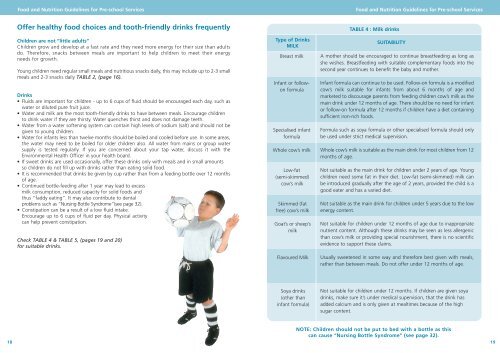Food and Nutrition Guidelines for Pre-school Services
Food and Nutrition Guidelines for Pre-school Services
Food and Nutrition Guidelines for Pre-school Services
Create successful ePaper yourself
Turn your PDF publications into a flip-book with our unique Google optimized e-Paper software.
18<br />
<strong>Food</strong> <strong>and</strong> <strong>Nutrition</strong> <strong>Guidelines</strong> <strong>for</strong> <strong>Pre</strong>-<strong>school</strong> <strong>Services</strong><br />
Offer healthy food choices <strong>and</strong> tooth-friendly drinks frequently<br />
Children are not “little adults”<br />
Children grow <strong>and</strong> develop at a fast rate <strong>and</strong> they need more energy <strong>for</strong> their size than adults<br />
do. There<strong>for</strong>e, snacks between meals are important to help children to meet their energy<br />
needs <strong>for</strong> growth.<br />
Young children need regular small meals <strong>and</strong> nutritious snacks daily, this may include up to 2-3 small<br />
meals <strong>and</strong> 2-3 snacks daily TABLE 2, (page 16).<br />
Drinks<br />
• Fluids are important <strong>for</strong> children - up to 6 cups of fluid should be encouraged each day, such as<br />
water or diluted pure fruit juice.<br />
• Water <strong>and</strong> milk are the most tooth-friendly drinks to have between meals. Encourage children<br />
to drink water if they are thirsty. Water quenches thirst <strong>and</strong> does not damage teeth.<br />
• Water from a water softening system can contain high levels of sodium (salt) <strong>and</strong> should not be<br />
given to young children.<br />
• Water <strong>for</strong> infants less than twelve months should be boiled <strong>and</strong> cooled be<strong>for</strong>e use. In some areas,<br />
the water may need to be boiled <strong>for</strong> older children also. All water from mains or group water<br />
supply is tested regularly. If you are concerned about your tap water, discuss it with the<br />
Environmental Health Officer in your health board.<br />
• If sweet drinks are used occasionally, offer these drinks only with meals <strong>and</strong> in small amounts<br />
so children do not fill up with drinks rather than eating solid food.<br />
• It is recommended that drinks be given by cup rather than from a feeding bottle over 12 months<br />
of age.<br />
• Continued bottle-feeding after 1 year may lead to excess<br />
milk consumption, reduced capacity <strong>for</strong> solid foods <strong>and</strong><br />
thus “faddy eating”. It may also contribute to dental<br />
problems such as “Nursing Bottle Syndrome”(see page 32).<br />
• Constipation can be a result of a low fluid intake.<br />
Encourage up to 6 cups of fluid per day. Physical activity<br />
can help prevent constipation.<br />
Check TABLE 4 & TABLE 5, (pages 19 <strong>and</strong> 20)<br />
<strong>for</strong> suitable drinks.<br />
Type of Drinks<br />
MILK<br />
Breast milk<br />
Infant or followon<br />
<strong>for</strong>mula<br />
Specialised infant<br />
<strong>for</strong>mula<br />
Whole cow’s milk<br />
Low-fat<br />
(semi-skimmed)<br />
cow’s milk<br />
Skimmed (fat<br />
free) cow’s milk<br />
Goat’s or sheep’s<br />
milk<br />
Flavoured Milk<br />
Soya drinks<br />
(other than<br />
infant <strong>for</strong>mula)<br />
<strong>Food</strong> <strong>and</strong> <strong>Nutrition</strong> <strong>Guidelines</strong> <strong>for</strong> <strong>Pre</strong>-<strong>school</strong> <strong>Services</strong><br />
TABLE 4 : Milk drinks<br />
SUITABILITY<br />
A mother should be encouraged to continue breastfeeding as long as<br />
she wishes. Breastfeeding with suitable complementary foods into the<br />
second year continues to benefit the baby <strong>and</strong> mother.<br />
Infant <strong>for</strong>mula can continue to be used. Follow-on <strong>for</strong>mula is a modified<br />
cow’s milk suitable <strong>for</strong> infants from about 6 months of age <strong>and</strong><br />
marketed to discourage parents from feeding children cow’s milk as the<br />
main drink under 12 months of age. There should be no need <strong>for</strong> infant<br />
or follow-on <strong>for</strong>mula after 12 months if children have a diet containing<br />
sufficient iron-rich foods.<br />
Formula such as soya <strong>for</strong>mula or other specialised <strong>for</strong>mula should only<br />
be used under strict medical supervision.<br />
Whole cow’s milk is suitable as the main drink <strong>for</strong> most children from 12<br />
months of age.<br />
Not suitable as the main drink <strong>for</strong> children under 2 years of age. Young<br />
children need some fat in their diet. Low-fat (semi-skimmed) milk can<br />
be introduced gradually after the age of 2 years, provided the child is a<br />
good eater <strong>and</strong> has a varied diet.<br />
Not suitable as the main drink <strong>for</strong> children under 5 years due to the low<br />
energy content.<br />
Not suitable <strong>for</strong> children under 12 months of age due to inappropriate<br />
nutrient content. Although these drinks may be seen as less allergenic<br />
than cow’s milk or providing special nourishment, there is no scientific<br />
evidence to support these claims.<br />
Usually sweetened in some way <strong>and</strong> there<strong>for</strong>e best given with meals,<br />
rather than between meals. Do not offer under 12 months of age.<br />
Not suitable <strong>for</strong> children under 12 months. If children are given soya<br />
drinks, make sure it’s under medical supervision, that the drink has<br />
added calcium <strong>and</strong> is only given at mealtimes because of the high<br />
sugar content.<br />
NOTE: Children should not be put to bed with a bottle as this<br />
can cause “Nursing Bottle Syndrome” (see page 32).<br />
19


